
Treating Burns Page Selection Menu: 1 2 3 4 5 6 7 8 9 10 Next>>
Treating Burns During the Golden Age of Piracy, Page 4
Burn Treatment Theory
"Forasmuch as it often happens, that in close Fights at Sea men are sometimes burnt by Gun-powder by
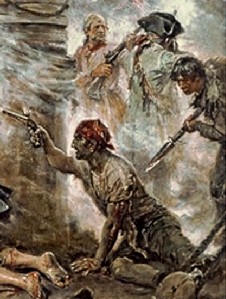
Artist: Jean Leon Gerome Ferris
Wounded Men In Battle, Taken from
Capture of the Pirate, Blackbeard (1920)
their Enemies, and by various Accidents amongst themselves; I shall therefore deliver to you the most plain way of curing them. For, however people, cry, It’s nothing to cure a Burn: Yet by what I have seen of these Cures from Country or City, they are often very ill performed. Whether they are burnt by Gun-powder or any other way, their Cure is much alike, they only differing secundum magis & minus. [according to how bad they are]." (Richard Wiseman, Of Wounds, Severall Chirurgicall Treatises, p. 440)
Much of the theory of treating burns relies on the old, now obsolete concept of humors. Nearly everything concerned with medicine was tied into humorism from ancient times until well into the 19th century. The golden age of piracy was no different and burn sites were believed to be a focal point of 'bad' humors.
The other primary part of burn treatment theory will be familiar to those with a passing knowledge of first aid. In the early 17th century William Fabry aka. Guilelmus Fabricius Hildanus, the German 'Father of Surgery', wrote about burns, dividing them into 1st, 2nd and 3rd degrees. Today there is also a 4th degree burn classification for body parts which basically are destroyed, requiring amputation, but that classification did not exist at this time in history.
We'll look first at humoral theory and then at the 3 divisions of burns written about by Fabry.
Burn Treatment Theory - Humors
Classical theory
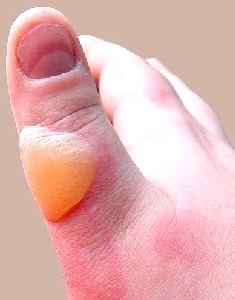
Photo: Wiki User Snickerdo
The Accumulation of a LOT of Bad Humors
from a scald burn
still held sway in the late 17th and early 18th centuries; the 5th - 4th BC works of Hippocrates, widely cited as the source of much of medicinal humoral theory were still taught along with the 1st century writings of Galen. So it should not be very surprising that 'bad' humors were thought to collect at the wound site of a burn.
William Fabry explained that "as soone as ever the fire or the firy substance hath touched the skin, the radicall moisture is presently dryed from the part; hereby the skin waxeth hard, and is drawn together. The rest of the Humour which remaineth within the skin and the parts adjacent, becommeth very hot, and getteth the nature of the Fire."1 Thus, according to Fabry, whatever scorches the body part forces out the 'good' humors and allows the 'bad' ones to remain at the wound site.
'Bad' humors, left to their own devices, "raise intolerable pain, which draweth into it many humours from the parts adjacent, which (if the Combustion be but light) doth run together under the upper skin and hardneth the same, by reason of the strength of the Fire; and not admitting transpiration [natural evaporation - sweat] they are lifted up, and hereby come pustels"2. Fabry thus suggests the formation of blisters are a result of the gathering of more 'bad' humors which were attracted to each other once the good humors are removed by the burning agent.
He further
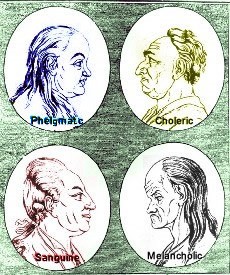
Artist: J.C. Lavanters
The Four Humoral Body Types - Phlegmatic,
Choleric, Sanguine and Melancholic
From Physiognomische
Fragmente
zur Beförderung (1783)
explains that pain of such a wound causes "the Humours which are ingendred and whatsoever else is retained and imprisoned under that hard skin [to] flow thither by reason of the paine, whereby not onely the heat which they have received of the Fire is increased; but also what blood or Humours soever doth flow from the body and the parts adjacent, do also wax hot and burning, and doe get a certaine sharpe and biting quality: Hereby it commeth to passe, that the Humours doe crode [corrode] and knaw the place affected, and doe cause a great Ulcer."3
Drawing further upon humorism, Fabry reveals that different humoral body types will affect the healing of burns. "In wholsome and well-tempered bodies Combustions is healed with a little labour: Contrary in foule and plethorique bodies, it is hardly cured, and doth easily grow to a putrid ulcer. For paine doth continually draw unto it Humours and blood from the Body, hereby the part affected, waxeth hot, and inflamed, and divers and naughty Symptomes doe follow."4
Humor theory had several facets and one of them suggested that a person's appearance and body shape were based on their being one of four humoral 'types.' According to his theory, the sanguine or plethoric body type would be more liable to the effects of 'bad' humors because of the excess of blood such a body type would contain.
1 Guliielm. Fabritius Hildanus (aka William Fabry), His Experiments in Chyrurgerie, p. 1; 2 Hildanus, p. 2; 2 Hildanus, ibid.; 4 Hildanus, p. 9
Burn Treatment Theory - Humors in Practice
"Here is required Bleeding and Evacuation by Lenients [mildly purging medicines]: but if there be Cacochymia [corrupt humors], you must purge more powerfully. A spare Diet is requisite, with all other Regulation proportionably according as the Burn is greater or less."(Richard Wiseman, Of Wounds, Severall Chirurgicall Treatises, p. 441)
While the period surgeons do not
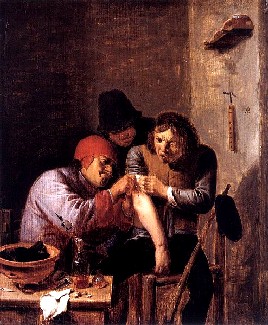
Photo: Adriaen Brouwer
Bleeding a Patient - Feeling (1635)
delve into humoral theory in depth, they do have much to say about the practical aspects of dealing with humors that result from burning. In the leading quote for this section, Wiseman mentions three treatments often associated with humoral theory: bleeding or removal of blood (one of the four humors thought to be in the body), purging the digestive system, and a spare, or light diet to limit the body's ability to produce new blood and thus new humors. Let's examine the period surgical view of each of these.
Bloodletting
Sea surgeon John Woodall advises the surgeon treating burns "that blood letting be used, which is very requisite to avert fluxions [diarrhea], and to avoide putrefactions of humours."1 Putrefaction of humors is an ancient Galenic medicinal concept2 which suggests that 'good' bodily humors are corrupted by wounds or an ill body and turned into 'bad' humors which continue to cause harm to the patient and delay effective healing.
Sea surgeon John Moyle likewise recommends that "Phlebotomy is to be Celebrated to oppose a Fever; which is apt to seize in this Case."3 He touches here upon the idea that unbalanced or corrupt humors are the cause of fevers, a concept repeated in several physician's books from this time period. In a case involving a burn patient, Richard Wiseman explains that a patient contracted a fever which was "great by reason of the Pain", noting that the patient "should have been let blood, but would not [allow it]."4
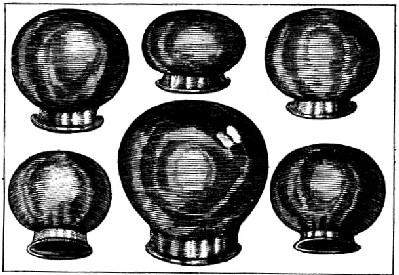
A Variety of Cupping Glasses, from Exercitationes Practicae
Circa Medendi Methodum, by Frederici Dekkers
William Fabry suggests the use of several different sorts of blood drawing procedures including "blood-letting, cupping, and other revultions, that the humours and blood may be drawne and evacuated to the other part"5.
'Revultion' or revulsion is a humoral theory that recommends diverting the formation and attraction of 'bad' humors to a wound through the use of bleeding and cupping. (Cupping glasses like those seen here are used to form a vacuum on a body part to attract humors in the skin on which they are placed.) Revulsion suggests that the surgeon perform these operations on the side of the body opposite the wound location. The idea is that the bad humors will be attracted to the cupped or bled area away from the wound site.
Purging
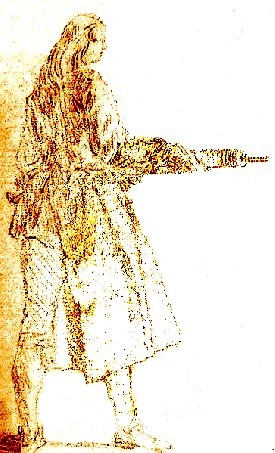
Photo:Jean-Antoine Watteau
The Man With the Clyster Syringe (1700)
There were two methods for purging the digestive system. One was to purge upwards through the use of emetic medicines. In the quote leading this section, Richard Wiseman advises the use of 'Lenients' for simple burns and stronger purging medicines when corrupt humors are present. (Possibly referring to the more violent burns, although corrupt humors seem to have been a facet of all types of burns according to William Fabry as we shall see..) Emetics cause the patient to vomit and, presumably, eject the material that would create more bad humors which would then flow towards the wound-site. Like Wiseman, William Fabry advises the use of purging medicines.6
John Woodall is a bit more circumspect in his recommendations for such medicines, telling his readers to "abstaine from purging potions, and the like at the first", hinting that they might be "administred in their due time and place"7 without explaining when or how.
The other humoral purging method was through the use of clysters or enemas, which purge the intestines. In his description of a burn patient, Richard Wiseman notes that "Clysters were admitted"8 as part of his treatment. John Moyle explains that the patient's "Body is to be kept Cool and open with Clysters"9. He goes into further detail in another book, explaining that when treating a burn patient, "heat will make him Costive [constipated]; [so] give him Clysters and let him blood (if the burn be deep)"10.
The last thing Wiseman mentioned in the quote leading this section was the use of a spare diet in healing. When discussing burns, Moyle likewise suggests that a "spare and Salutiferous Diet is to be ordered as in all wounds"11, proposing in another place a diet containing "Grewel, with Currans and Spice in it; and sweetned with Sugar, as also Barley-water for their Drink"12.
Woodall gives a slightly different recommendation, explaining that with "a good dyet, the Surgeons Mate shall performe much in short time"13 to help burn patients. What a good diet includes is not detailed here. William Fabry suggests that the patient maintain a 'dyet' appropriate for the topical medicines being used14, but he doesn't enlarge upon that either.
1 John Woodall, the surgions mate, p. 146; 2 See Galen, Method of Medicine, Volume III: Books 10-14, Loeb Classical Library for several examples; 3 John Moyle, The Sea Chirurgeon, p. 98; 4 Richard Wiseman, Of Wounds, Severall Chirurgicall Treatises, p. 441; 5 Guliielm. Fabricius Hildanus (aka William Fabry), His Experiments in Chyrurgerie, p. 19; 6 Hildanus, ibid.; 7 Woodall, ibid.; 8 Wiseman, ibid.; 9 Moyle, ibid.; 10 John Moyle, Abstractum Chirurgæ Marinæ, p. 67; 11 Moyle, The Sea Chirurgeon, p. 98; 12 Moyle, p. 56; 13 Woodall, ibid.; 14 Hildanus, ibid.

